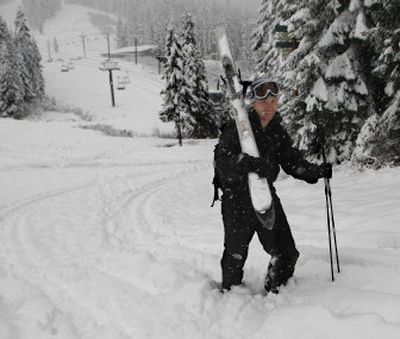Ski resorts hope to open early after celebrating early snowfall

SEATTLE – A year after a warm, dry winter doomed most of the ski season throughout the Pacific Northwest, a hefty dose of midfall snow has some Washington resorts gearing up to open earlier than they have in years.
“I cannot even see 5 feet out my window, it’s snowing so hard. There’s really no sign of it letting up anytime soon,” Crystal Mountain spokeswoman Tiana Enger said gleefully Tuesday, as the resort announced it will become the first in the state to open its slopes, on Friday.
That will make it the earliest opening in a decade at the resort east of Mount Rainier. The season started on Nov. 5 in 1994.
To the north, Mount Baker said it plans to open next Tuesday. It had about 3 feet of snow near the summit and 2 feet at the base — slightly more than Crystal was reporting.
With the National Weather Service predicting snow on both sides of the Cascades throughout the week, Mount Baker spokeswoman Gwyn Howat said the ski area east of Bellingham was expecting another 3 to 4 feet to fall by opening day.
“With that additional snow, we feel we’ll be able to open the mountain with as many lifts as possible and good conditions,” Howat said.
Despite the cold, wet weather, a statewide drought emergency declaration that began in March will remain in effect through the end of the year.
The reason: to give irrigation and water districts enough time to complete projects designed to get them in better shape for the next bout of dry weather, said Curt Hart, a spokesman in the state Department of Ecology’s water resources program.
November is typically one of Washington’s wettest months of the year, said Gary Schneider, a meteorologist for the National Weather Service’s Seattle office. The seasonal forecast calls for a “neutral year.”
“Historically, neutral years tend to be more active than not,” Schneider said. “In other words, you get more weather — not less. Around here, more weather means wetter.”
Nevertheless, it will be a while before hydrologists will be able to tell if the state’s water supply is officially on the rebound.
“Things are looking better,” Hart said. “We’ve gotten snow, but last year we got snow, too, and then we got all that rain in January,” washing away much of the snowpack. “That’s what we’re hoping doesn’t happen again this year.”
Scientists said a weak El Nino was partly to blame for the drought. El Ninos create warmer than normal temperatures in the Eastern Pacific and can cause either wetter or drier-than-usual conditions in Washington state. Last year, the weather pattern sent rain and snow that normally fall in the Northwest to Southern California and the rest of the Southwest.
The dismal 2004-05 ski season didn’t surprise John Gifford, general manager at Stevens Pass east of Seattle. “We knew it wasn’t going to be a great year, but we didn’t expect it would be as bad as it was,” Gifford said, citing forecasters’ predictions about El Nino conditions.
Stevens Pass needs at least 3 feet of snow to open, Gifford said. It had nearly a foot at the base on Tuesday, and Gifford estimated the summit had 15 or 16 inches.
That’s about what Mission Ridge in Wenatchee was reporting up high, with about 4 inches at the base. Snow’s been falling off and on since the middle of last week, but the resort plans to wait a while before opening.
“We need a couple more good storms before we feel comfortable opening,” Mission Ridge spokeswoman Jerri Barkley said.
At Mount Spokane, managers were hoping a heavy mix of rain and snow that was falling Tuesday would change to snow showers overnight.
“We’re pretty happy with everything so far. It sounds like we’re back to a normal weather pattern,” said Brad McQuarrie, Mount Spokane’s general manager. “I like the big years, but I’d take all the normal years if we could throw out years like last year.”
The Summit at Snoqualmie had no up-to-date information about conditions on its Web site or snow information line, and the number to its administrative office rang busy throughout the day Tuesday.